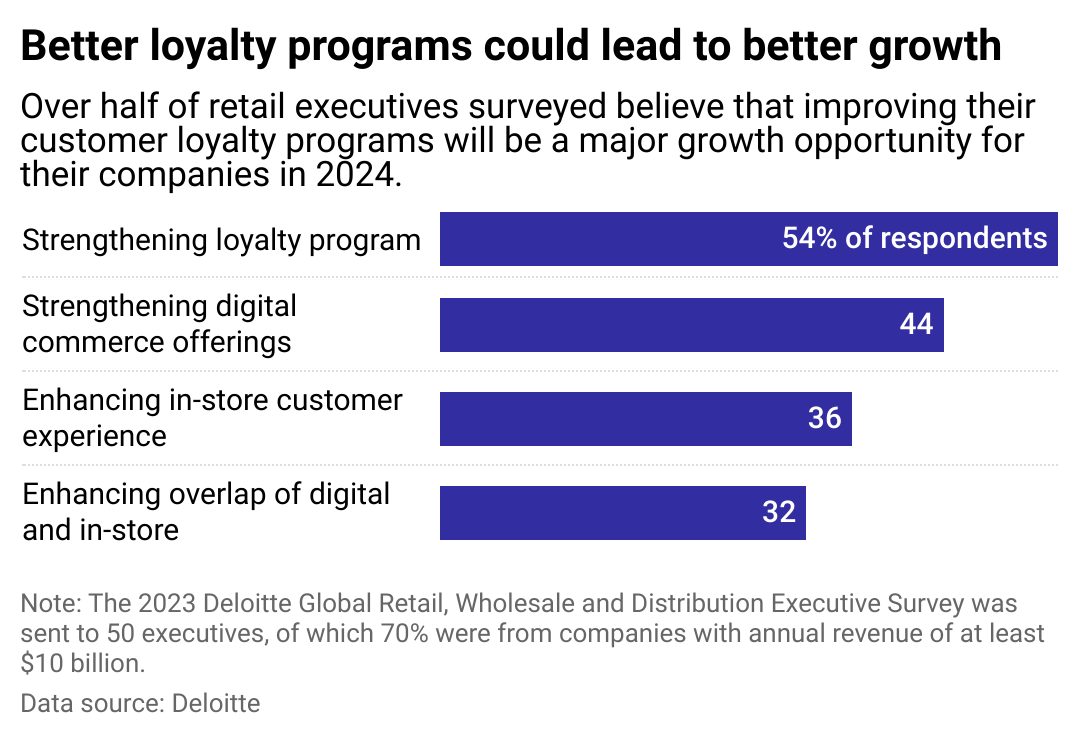What does brand loyalty look like now? Why businesses are revamping their customer rewards programs
Task Group analyzed Deloitte's 2024 retail industry outlook report to see how well customer rewards programs can strengthen brand loyalty.

It is a tough time to be in the retail business. Inflation has taken its toll on consumers' wallets in the past few years, and although prices are no longer rising as quickly as they did in 2022, they still are up by around 20% compared to the start of 2020.
These price increases have caused consumers to find more ways to save money. Discount stores were the hottest segment of the retail sector in 2023 and spending at discount retailers grew by 26%, according to Deloitte research. In contrast, spending at department stores fell by nearly 20%.
This in turn has put pressure on retailers, whose margins are already thin. Task Group analyzed survey data from Deloitte to see how retailers plan to face these challenges.
The Deloitte survey asked 50 senior executives from retail companies what they thought the biggest growth opportunities were for them in 2024. The most common response from the executives involved brand loyalty programs, such as those offering consumers points every time they make a purchase. Just over half of executives surveyed believed strengthening such programs would be a key area of potential.
Rewards are going digital

Customer rewards programs are nothing new. Such loyalty incentives have existed since at least 1793, according to a 1971 New York Times report, which reported a merchant in "Sudbury, [New Hampshire]" giving customers copper tokens they could redeem for merchandise in the future.
"Trading stamps" were popularized by the Sperry and Hutchinson Company in 1896. The company provided these stamps to retailers in New England, who then gave them to customers. Once they had filled their books, customers could redeem their stamps for goods from Sperry and Hutchinson.
Loyalty programs have come a long way since. Reward stamps are now rare, having been mostly replaced by digital accounts, with mobile apps playing a big role. This has created many opportunities for retailers, including the chance to create personalized shopping experiences for their customers by using data analysis to determine what kinds of rewards would work best for them.
The Deloitte report notes that Ulta Beauty grew its active loyalty program members from 30.7 million in the 2020 fiscal year to 40.2 million in 2022. This proved crucial, as over 94% of its sales came from such consumers.
Keeping customers is hard

The Deloitte report notes that digital rewards programs also give retailers a source of valuable data on their customers. When Apple launched stricter privacy rules on iOS in 2021, it hampered traditional media networks' ability to track consumers. This created an opportunity for retailers wanting to sell their customers' data to advertisers, though it raised questions about privacy.
Around 2 in 3 American consumers already belong to somewhere between 1 in 5 loyalty programs. Deloitte estimates most consumers use half or even fewer of their memberships. The challenge many retailers face is not signing up consumers but rather creating benefits and shopping experiences attractive enough for their existing consumers to use the memberships and stick around.
One potential source of silver lining is that customers are not solely focused on price. A different study, conducted by PwC, asked both company executives and consumers what they thought caused consumers to leave a company. Some 37% of executives surveyed said they believed customers left following price increases or the cessation of discounts. Yet only 17% of consumers polled agreed. Consumers were more than twice as likely to say a bad experience with their products or services would make them leave a brand.
In a time of prolonged inflation, companies might not have much more room to adjust their prices. This suggests companies can do well by focusing on quality over making painful decisions about prices.
Story editing by Mary Reardon. Copy editing by Paris Close.
This story originally appeared on Task Group and was produced and distributed in partnership with Stacker Studio.







